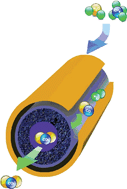A potential ionic liquid for CO2-separating gas membranes: selection and gas solubility studies
Abstract
The production of

* Corresponding authors
a
Chemical and Petroleum Engineering Department, School of Engineering, Shiraz University, Shiraz, Iran
E-mail:
raeissi@shirazu.ac.ir
b
Delft University of Technology, Faculty of Mechanical, Maritime and Materials Engineering, Department of Process and Energy, Laboratory of Process Equipment, Leeghwaterstraat 44, Delft, CA, The Netherlands
E-mail:
C. J.Peters@tudelft.nl
The production of

 Please wait while we load your content...
Something went wrong. Try again?
Please wait while we load your content...
Something went wrong. Try again?
S. Raeissi and C. J. Peters, Green Chem., 2009, 11, 185 DOI: 10.1039/B814246G
To request permission to reproduce material from this article, please go to the Copyright Clearance Center request page.
If you are an author contributing to an RSC publication, you do not need to request permission provided correct acknowledgement is given.
If you are the author of this article, you do not need to request permission to reproduce figures and diagrams provided correct acknowledgement is given. If you want to reproduce the whole article in a third-party publication (excluding your thesis/dissertation for which permission is not required) please go to the Copyright Clearance Center request page.
Read more about how to correctly acknowledge RSC content.
 Fetching data from CrossRef.
Fetching data from CrossRef.
This may take some time to load.
Loading related content
